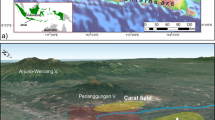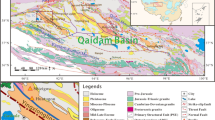Abstract
IT is widely accepted that natural gas is formed from thermal decomposition of both oil in reservoirs and, to a lesser extent, the organic matter in shales from which the oil was derived1–6. But laboratory pyrolysis experiments on shales do not reproduce the methane-rich composition typical of most gas reservoirs7, leading to suggestions7 that other mechanisms, such as transition-metal catalysis, may be important. The discrepancy might, however, instead arise because gas (and oil) deposits have migrated from their source rocks, so that the reservoir composition might not be representative of the composition in the source rocks where the hydrocarbons were generated. To address this question, we have analysed gas samples coproduced with oils directly from a source rock (the Bakken shales, North Dakota, USA) where the local geology has prevented significant hydrocarbon migration. The methane contents of these Bakken-shale gases are much lower than that of conventional gas reservoirs, but are consistent with that from pyrolysis experiments8,9 on these shales. Thus, because these Bakken gases form with (rather than from) oils, we argue that compositional differences between gases from source rocks and conventional gas deposits result from fractionation processes occurring after hydrocarbon expulsion from the source rock.
This is a preview of subscription content, access via your institution
Access options
Subscribe to this journal
Receive 51 print issues and online access
$199.00 per year
only $3.90 per issue
Buy this article
- Purchase on Springer Link
- Instant access to full article PDF
Prices may be subject to local taxes which are calculated during checkout
Similar content being viewed by others
References
Schoell, M. Bull. Am. Ass. Petrol. Geol. 67, 2225–2238 (1983).
James, A. T. Bull. Am. Ass. Petrol. Geol. 67, 1176–1191 (1983).
Schoell, M. Chem. Geol. 71, 1–10 (1988).
Galimov, E. M. Chem. Geol. 71, 77–96 (1988).
Chung, H. M., Gormaly, J. R. & Squires, R. M. Chem. Geol. 71, 97–104 (1988).
Clayton, C. Mar. Petrol. Geol. 8, 232–240 (1991).
Mango, F. D., Hightower, J. W. & James, A. T. Nature 368, 536–538 (1994).
Wenger, L. M. & Price, L. C. in Organic Geochemistry—Advances and Applications in Energy and the Natural Environment (ed. Manning, D. A. C.) 335–339 (European Association Organic Geochemists, Manchester, UK, 1991).
Price, L. C. in Sources of Natural Gas (eds Rice, D. & Schoell, M.) Chem. Geol. (in the press).
Tissot, B. P. & Welte, D. H. Petroleum Formation and Occurrence (Springer, New York, 1984).
Price, L. C. & LeFever, J. Bull. Can. Petrol. Geol. 42, 187–218 (1994).
Price, L. C. & LeFever, J. in Geological Studies Relevant to Horizontal Drilling: Examples from Western North America (eds Schmocker, J. W., Coalson, E. B. & Brown, C. A.) 199–214 (Rocky Mountain Association Geologists, Denver, 1992).
Rice, D. D., Threlkeld, C. N. & Vuletich, A. K. Open-File Rep. 88–391 (US Geol. Surv., 1988).
Salisbury, G. P. Mem. Am. Ass. Petrol. Geol. Mem. 9, V. 2 1433–1445 (1968).
Gussow, W. C. Bull. Am. Ass. Petrol. Geol. 38, 816–853 (1954).
Jenden, P. D., Newell, K. D., Kaplan, I. R. & Watney, W. L. Chem. Geol. 71, 117–147 (1988).
Fuex, A. N. J. Geochem. Explor. 7, 155–188 (1977).
Namak, J. E. & Sigier, S. Information Circ. No. 9301 (Bureau of Mines, US Dept of Interior, Pittsburgh, 1991).
McNeil, R. I. & BeMent, W. O. Energy and Fuels (in the press).
Price, L. C. & Barker, C. E. J. Petrol. Geol. 8, 59–84 (1985).
Author information
Authors and Affiliations
Rights and permissions
About this article
Cite this article
Price, L., Schoell, M. Constraints on the origins of hydrocarbon gas from compositions of gases at their site of origin. Nature 378, 368–371 (1995). https://doi.org/10.1038/378368a0
Received:
Accepted:
Published:
Issue Date:
DOI: https://doi.org/10.1038/378368a0
Comments
By submitting a comment you agree to abide by our Terms and Community Guidelines. If you find something abusive or that does not comply with our terms or guidelines please flag it as inappropriate.



